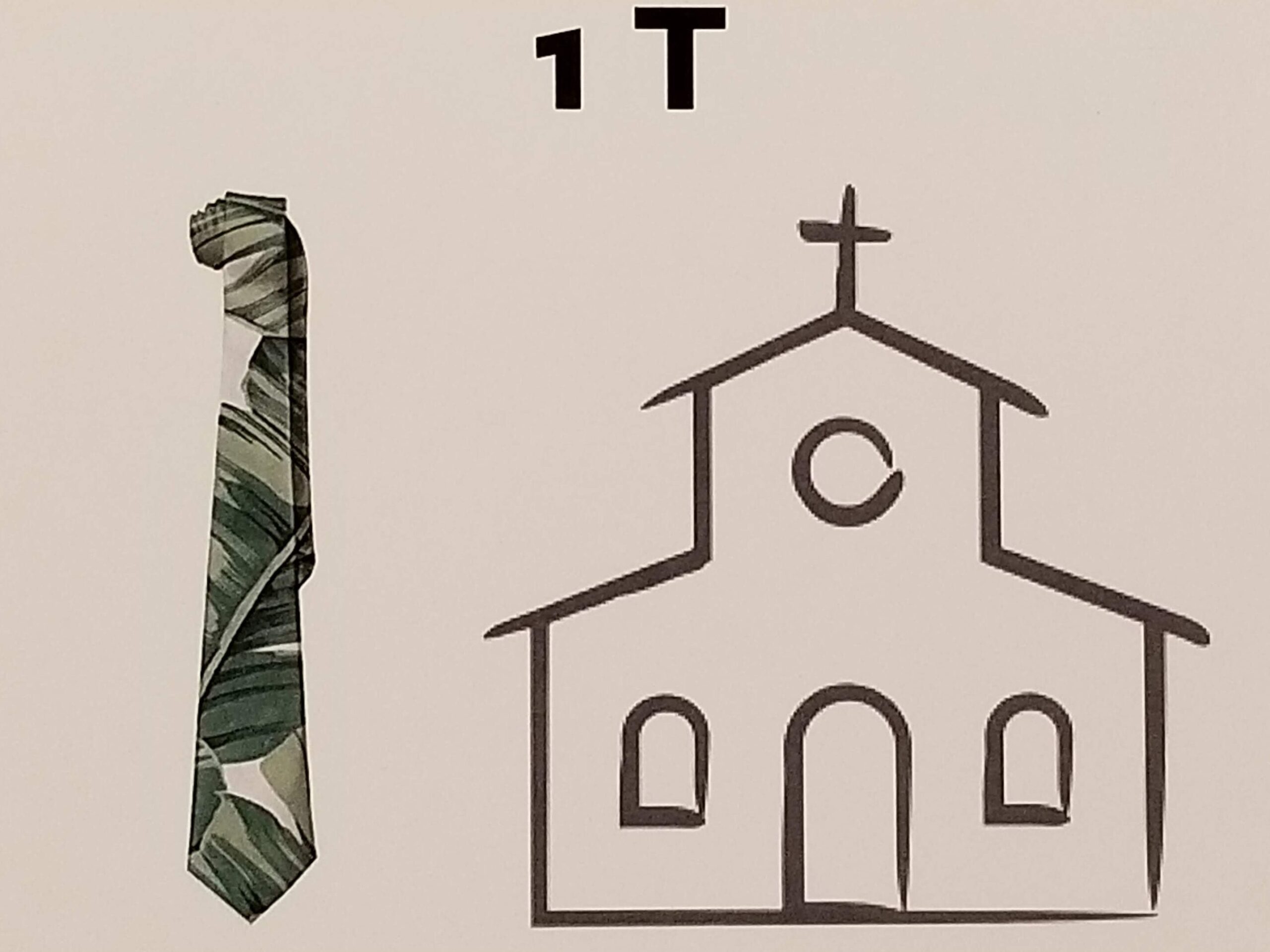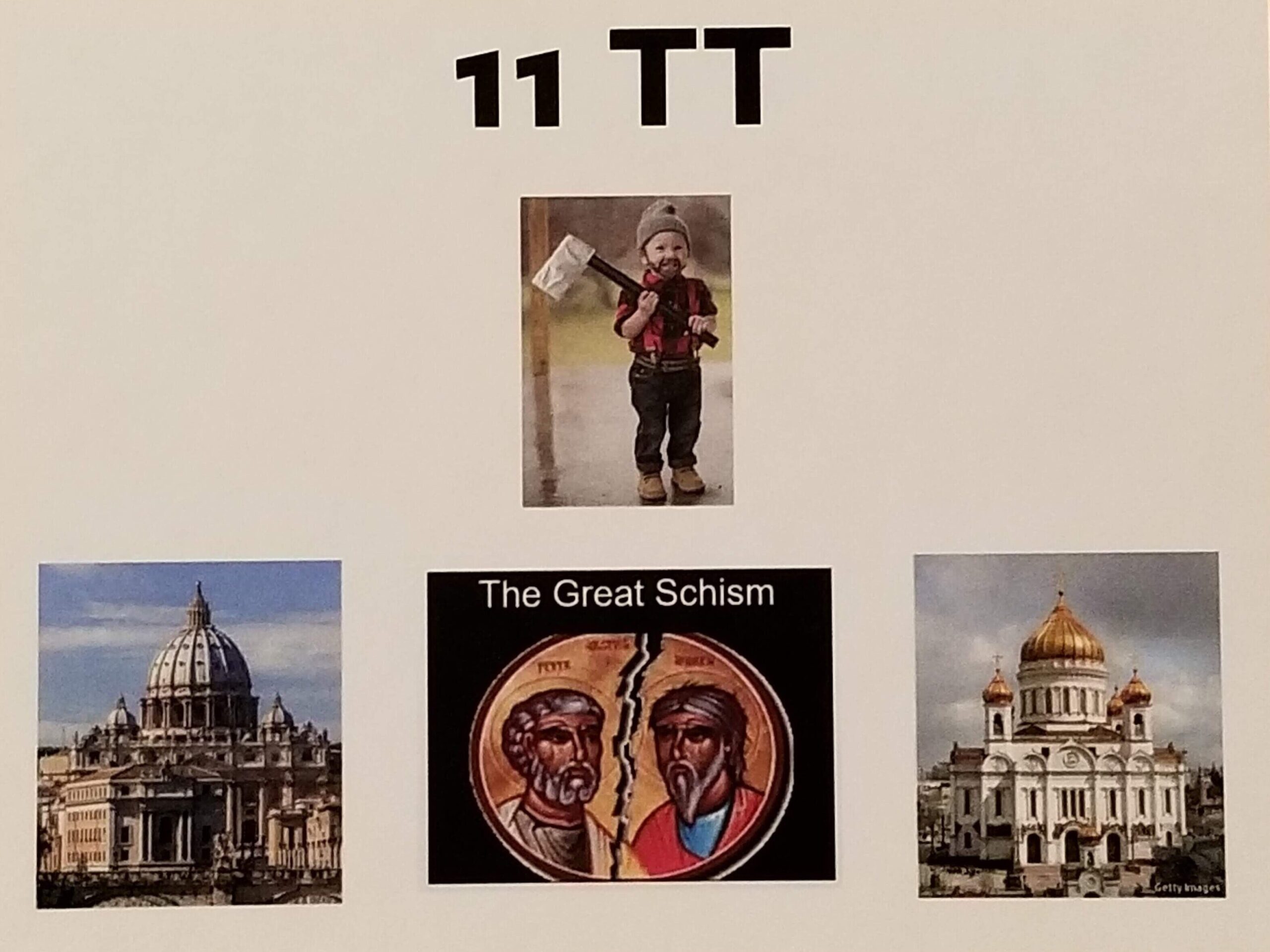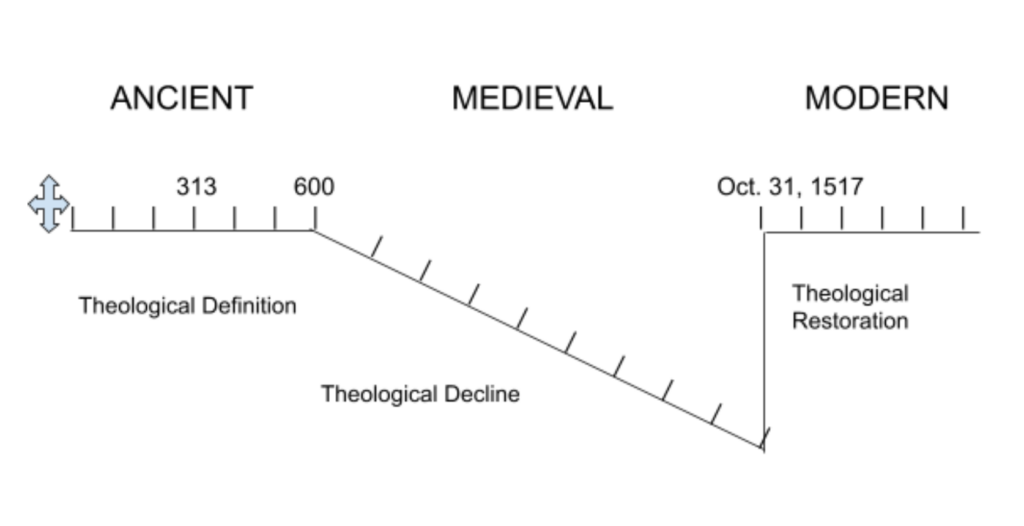How is it even possible to memorize 20 Centuries of Church History? That’s what I wondered when I began a Church History course. Yet by the end of class, I wrote out–by memory–a detailed timeline covering 2000 years …
The professor for the course incorporated the use of a peg-word system (or Major System) as the standard way to memorize numbers in English. This mnemonics technique converts numbers into words and images. It sounds crazy, but it actually works!
Peg Words: Numbers 1-20
In the peg-word system, each number, zero to nine, is allocated a consonant sound. Then you use images to remember each number; you simply add on to numbers 10 and above, and develop additional images for each.
For example, the peg word we used for number 1 is “Tie” and the peg word for number 11 is “Tot.” Below are my images I used to incorporate these for the Key Ideas of Church History of the 1st Century and the 11th Century.
To gain a better understanding, be sure to read the “Key Ideas of Church History” explained below …


Key Ideas of Church History
As part of the Church History Final Exam, we wrote out for memory the Key Ideas of the past 20 centuries, and described the images used for our Memory Project. I hope you will enjoy reading these, and gain a brief overview of how our Great God has been working in and through His Church since the time of Jesus!
1st Century:
The Church Planted, Equipped and Sent
1=T
Tie
Description: Necktie with green plant design, and a simple church building; representing the church being planted, equipped with the Holy Spirit and apostles, and sent “to seek and save the lost”
2nd Century:
Faithful, but Flawed
2=N
Noah
Description: Noah with blueprints of the ark, and a large broken diamond wedding ring; representing the faithful church leaders but recognizing their flaws
3rd Century:
External Persecution and Internal Corruption
3=M
Ma
Description: Ma Kettle, with a large purse containing a chariot wheel and the Libellius on one side, and an X-ray with a cowboy riding a lightning bolt on the other; representing the external persecutions (social, religious, political, etc.) and the internal corruption (Moranism, Gnosticism, etc.) within the church
4th Century:
Constantine the Great
4=R
Rye
Description: Loaf of rye bread, with Constantine the Great, plus images of the Arian and Donatist Controversies, and the Edict of Milan in 313 that made Christianity legal
5th Century:
Golden Age of the Church Fathers
5=L
Law
Description: Lawman/Sheriff of the West with a gold star, and an image with church fathers including Augustine, Jerome and John Chrystostom “Golden Mouth” inside a Catholic church, and an image of Pelagius; representing these church fathers who had the freedom to write and speak freely
6th Century:
Age of the Monasteries
6=Sh
Shoe
Description: Old Mother Hubbard’s shoe filled with her and lots of children, and an image of four monks; representing the age of monks such as St. Anthony, Pachius, St. Simeon, and St. Basil, as well as the rise of asceticism and rapid growth of monasteries
7th Century:
The Pope and The Prophet
7=K
Cow
Description: Black-and-white jersey cow, with an image of Gregory the Great on one side, and Mohammed on the other side; representing the reign of Gregory the Great (the first medieval pope) during the beginning of the Medieval period, as compared Mohammed, The Prophet, and the beginning and rapid spread of Islam
8th Century:
Charles the Great
8=V
Ivy
Description: An ivy plant, and an image of Charles the Great with a cross and sword; representing the impressive rule and reign of Charlemagne (with an expansive empire, widespread of education, and church reforms)
9th Century:
Collapse of the West
9=B
Bee
Description: Bumble bee with a viking helmet, and an image of a map with a golden statue of Charlemagne, and another map with the empire divided; representing the fighting among Charlemagne’s heirs leading to the collapse of the Western empire and the division of the empire into three areas; the bee’s viking helmet is a reminder of the devastation caused by the invasion of the vikings and the beginning of feudalism
10th Century:
Conversion of the Slavs
10=TT
Toes
Description: Ten toes of a marble statue, with an image of Cyril and Methodius on one side, and an icon of Olga and Vladimir on the other side; representing the monk brothers of Cyril and Methodius who evangelized the Slavs, while Olga of Kiev and her grandson, Vladimir, were the first Christian rulers of Russia
11th Century:
The Church Divided
11=TT
Tot
Description: Tot dressed as a lumberjack and holding an axe, with a Roman Catholic church building on one side, and a Orthodox church building on the other side; representing the Great Schism that forever split Christianity into two divisions
12th Century:
The First Crusade
12=TN
Tuna
Description: A tuna fish, and an image of crusaders with red-cross armor on horseback; representing the First Crusade military effort to win back the Holy Land from the Muslims
13th Century:
The Birth of the Universities
13=TM
Tome
Description: A large tome/book, with an image of the Fourth Crusade/Fall of Constantinople, and a painting of Thomas Aquinas holding a university building and a book; representing the Fourth Crusade where invading crusaders turned against other Christians for material gain, and the time of Thomas Aquinas and Scholasticism
14th Century:
Western Schism / The Time of the Three Popes
14=TR
Tower
Description: A medieval tower, and “The Time of the Three Popes” book cover; representing the Western Schism when two popes, then three popes, vied for supremacy (in Rome, Avignon and Pisa)
15th Century:
The Morning Stars of the Reformation
15=DL
Dial
Description: A medieval clock dial with a design of the cosmos, and a bright morning star, next to images of John Wycliffe and Jan Hus; representing the early reforming work of John Wycliffe (questioned practices of the Pope and clergy, translated/distributed the English Bible) and Jan Hus (burned at the stake for heresy against Catholic doctrines)
16th Century:
Reformation
16=DSh
Dish
Description: Ceramic dish from the 16th century, and images of Martin Luther and his 95 Theses, and John Calvin and his writings; representing Martin Luther’s posting the 95 Theses on October 31, 1517 in Germany, officially kicking off the Reformation (as well as ending the Medieval Period and beginning the Modern period), and John Calvin leading the reformation in Geneva (his doctrine leading to Calvinism)
17th Century:
Wars of Religion
17=TK
Tick
Description: A large tick, and an image of the Wars of Religion, including the Thirty Years’ War, and a description of the four phases of the war; representing the devastation and bloodshed of the Thirty Years’ War that started out local and religious (Protestants against Catholics) but became continental and political
18th Century:
Great Awakenings
18=DV
Dove
Description: Dove with an olive branch, and images of some of the leaders of the revivals; representing the peace after century of war, plus the Holy Spirit’s work of revivals, including Count Zinzendorf and the Moravians, and four Protestant revivalists (including Jonathan Edwards, John Wesley, George Whitefield, and Charles Wesley), all happening around the time of Enlightenment and the French Revolution
19th Century:
Age of Skepticism / Great Century of Missions
19=TB
Tube
Description: Tube of toothpaste with two colors/flavors, and an image of a brain in a pot of water and “Skepticism,” next to an image with a globe surrounded by a cross and a “Missions” archway; representing the Age of Skepticism that included Darwinism and Modernism, as compared to missions and missionaries going to the world (Europe, England, China, etc.)
20th Century:
Age of Ideologies / Age of Mass Evangelism
20=NS
Nose
Description: A nose, with an image of five world leaders, and a “Mass Evangelism” sign surrounded by masses of people; representing an Age of Ideologies (communism, nazism, etc.) which was a war of ideas of world leaders (Stalin, Hitler, etc.) that led to real wars (World War I & II), as compared to the Age of Mass Evangelism that included new approaches (Billy Graham’s televised crusades) and new tools (JesusFilm)
Church History Timeline
I also wanted to share a Church History Timeline that we had to memorize for the class. I found it to be a very helpful diagram in understanding the major periods of the 20 Centuries of Church History. This is the version I recreated for the exam.

Thanks for reading through all of this! I know it’s rather complex and challenging to follow, but I hope it has been insightful and perhaps even educational or spiritually intriguing.
Please let me know what you think about it or if you have questions. My contact info is on the home page.